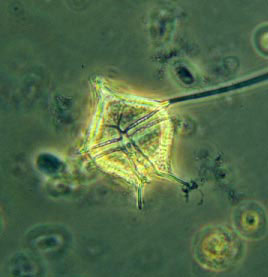
Adaptation
 temporary resting state—pellicle, temporary or ecdysial cyst; or a
dormant zygote—resting cysts or hypnozygotes. To adapt to cooler
temperatures, absence of light, or salinity effects, dinoflagellates
evolved a cyst phase and avoid hindrance of vegetative growth. The
cysts are cylindrical with rounded ends. The wall is clear and is
usually covered with a mucous substance. Internally, the cell
contains granular material, an orange-red accumulation body (that
forms the color of red tide) and numerous lipid globules. Temporary
cysts are formed under adverse conditions. Once conditions in the
environment are favorable, the cyst will split and a new flagella
will form allowing it to swim freely once again. For Gonyaulax
catenella and Alexandrium catenella, these organisms
form a temporary resting cyst in the winter months while the marine
waters are very cold and icy. Other interactions include salinity
and oxygen concentrations, and nutrient rich mediums.
temporary resting state—pellicle, temporary or ecdysial cyst; or a
dormant zygote—resting cysts or hypnozygotes. To adapt to cooler
temperatures, absence of light, or salinity effects, dinoflagellates
evolved a cyst phase and avoid hindrance of vegetative growth. The
cysts are cylindrical with rounded ends. The wall is clear and is
usually covered with a mucous substance. Internally, the cell
contains granular material, an orange-red accumulation body (that
forms the color of red tide) and numerous lipid globules. Temporary
cysts are formed under adverse conditions. Once conditions in the
environment are favorable, the cyst will split and a new flagella
will form allowing it to swim freely once again. For Gonyaulax
catenella and Alexandrium catenella, these organisms
form a temporary resting cyst in the winter months while the marine
waters are very cold and icy. Other interactions include salinity
and oxygen concentrations, and nutrient rich mediums.Along with adaptations to adverse environments, G. catenella habitually reproduces in chains versus singularly because of the benefit the protist gains in doing so. Chain formation facilitates a life cycle benefit. Weakly swimming gametes are vulnerable to physical dispersion, and when parent cells cluster into chain, it reduces the swimming distance between mating types and ultimately facilitates mating. Because the organism can sense turbulence in water, a reaction time trait came about in three different adaptive responses. Exposure to turbulence stimulates its chain formation, increases its swimming velocity, and influences the cells and chains to change swimming direction and behavior to heighten survival and growth.
 © Smithsonian Environmental Research Center
© Smithsonian Environmental Research Center
Phtotaxis is defined as the movement away from or towards a light source. Gonyaulax adapted to light stimulus by swimming with its two posterior flagella to obtain nutrients. Phototaxis aids in a night and day migration behavior that is regulated by irradiance intensity and spectral quality. It promotes environmental exploration and movement to more optimal strata within the water column. Swimming enables nutrient- deficient cells to undertake nutrient- gathering migration to deeper nutrient-rich layers where they dark-assimilate nitrates for photosynthetic nutrient uptake upon swimming back up into the optimal zones.
To adapt to the the temporal cyclic structures of the environment such as day, dusk, night, and tides, organisms have developed biological clocks—or circadian rhythms to specialize in their environments. Circadian systems are endogenous mechanism which oscillate, with a period length close to one of temporal structures. The feature that controls circadian rhythms is know as an oscillator. The oscillator responds to environmental stimuli and reacts accordingly for the organism through a system of input and output feedback loops at a cellular level. These systems enable organism to schedule functions like feeding, enzyme activity, and reproduction
Check out other organism that exhibit adaptations to phototaxis Pacific Bleeding Heart and Blood Root.These adaptations by Gonyaulax aid in survival, including feeding. Follow the link to learn about this organism's Nutrition!